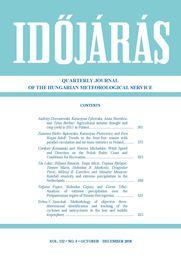IDŐJÁRÁS - angol nyelvű folyóirat
Vol. 122, No. 4 * Pages 361–462 * October - December 2018
 |
|
 letöltés [pdf: 2129 KB]
letöltés [pdf: 2129 KB]
Agricultural autumn drought and crop yield in 2011 in Poland
Andrzej Doroszewski, Katarzyna Żyłowska, Anna Nieróbca, and Tytus Berbeć
DOI:10.28974/idojaras.2018.4.1 (p. 361–)
Andrzej Doroszewski, Katarzyna Żyłowska, Anna Nieróbca, and Tytus Berbeć
DOI:10.28974/idojaras.2018.4.1 (p. 361–)
Trends in the frost-free season with parallel circulation and air mass statistics in Poland
Zuzanna Bielec-Bąkowska, Katarzyna Piotrowicz, and Ewa Krępa-Adolf
DOI:10.28974/idojaras.2018.4.2 (p. 375–)
Zuzanna Bielec-Bąkowska, Katarzyna Piotrowicz, and Ewa Krępa-Adolf
DOI:10.28974/idojaras.2018.4.2 (p. 375–)
Wind speed and direction on the Polish Baltic coast and conditions for recreation
Czesław Koźmiński and Bożena Michalska
DOI:10.28974/idojaras.2018.4.3 (p. 393–)
Czesław Koźmiński and Bożena Michalska
DOI:10.28974/idojaras.2018.4.3 (p. 393–)
Rainfall erosivity and extreme precipitation in the Netherlands
Tin Lukić, Biljana Basarin, Tanja Micić, Dajana Bjelajac, Tiemen Maris, Slobodan B. Marković, Dragoslav Pavić, Milivoj B. Gavrilov, and Minučer Mesaroš
DOI:10.28974/idojaras.2018.4.4 (p. 409–)
Tin Lukić, Biljana Basarin, Tanja Micić, Dajana Bjelajac, Tiemen Maris, Slobodan B. Marković, Dragoslav Pavić, Milivoj B. Gavrilov, and Minučer Mesaroš
DOI:10.28974/idojaras.2018.4.4 (p. 409–)
Analysis of extreme precipitation over the Peripannonian region of Bosnia Hercegovina
Tatjana Popov, Slobodan Gnjato, and Goran Trbić
DOI:10.28974/idojaras.2018.4.5 (p. 433–)
Tatjana Popov, Slobodan Gnjato, and Goran Trbić
DOI:10.28974/idojaras.2018.4.5 (p. 433–)
Methodology of objective three-dimensional identification and tracking of cyclones and anticyclones in the low and middle troposphere
Evhen V. Samchuk
DOI:10.28974/idojaras.2018.4.6 (p. 453–)
Evhen V. Samchuk
DOI:10.28974/idojaras.2018.4.6 (p. 453–)
IDŐJÁRÁS folyóirat

Az IDŐJÁRÁS a HungaroMet Nonprofit Zrt. negyedévenként megjelenő angol nyelvű folyóirata
Megrendelhető a journal.idojaras@met.hu címen.
A szerzőknek szánt útmutató itt olvasható.
Megrendelhető a journal.idojaras@met.hu címen.
A szerzőknek szánt útmutató itt olvasható.









